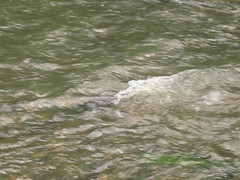Salmon gone wild

They are mostly dead now, lying pink in the shallow waters or caught in a snag on the Honey Grove. A few shadows still loom beneath the surface, flip sideways in the current, struggle in their fight for life, dying a lttle bit more with every extra effort to swim higher upstream. The Chinook are back.
It's our good fortune we live on a spawning creek for Chinook and Coho salmon because we get to see an incredible act of inherited memory. There is nothing more mesmerizing than standing on the creek bank looking (listening really) for the telltale fins and churning water, signs the fish have returned. I feel like I am in the middle of a National Geographic special. Greg says it is their sense of smell that leads these fish back to where they were born. Janet says to watch as they swim upsteam in pairs or more, several males fighting for the right to fertilize the eggs laid in the sandy shoals just before the adults die*.
On the Honey Grove it seemed we had more salmon coming upstream this year than past seasons. Maybe the deluge last winter gave the stream beds a good cleaning. The locals say it is nothing like thirty years ago. "There were so many fish we could almost walk across their backs." Fish so thick they filled the streams to the banks? Of course we had our own fish stories this year. "You can't believe it! These fish are three, four feet long...or maybe two and a half." I think it was the magnification in the water. Maybe that is how all fish stories begin.
I have one other fish story to tell, in the event it helps someone down the line. It is local to the Northwest, about the darker history of dead and dying salmon. At least for people who have dogs. Dead salmon poisons dogs. We learned this our first year living on the Honey Grove because we have Cisco, a dog with a small brain when it comes to food; one who will eat sheep poop, and horse poop, and geese poop, and apparently dead stinky fish. I had been forewarned by a farm neighbor and was almost ready with the medicine I needed. I had meant to buy it, but decayed fish wasn't yet top of mind in those early days.
I ended up having to make a special trip to town for Terramaycin since the Alsea Mercantile, that has almost anything one could need, did not have this particular antibiotic, and my dog was dying. You have about three days to catch the symptoms and then you either lose the dog or have an extremely expensive vet bill and a dog with liver damage. I think I caught it at day two, plus the hours it took to drive 40 miles to and from town. I haven't seen Cisco interested in eating fish since that summer, but they say the dogs that survive gain a natural immunity. He still eats poop, so fish is not a stretch.
Which leads me to this conclusion. If you ever come to our farm in the fall you may get the chance to see the salmon fighting up the creek and be part of your own National Geographic special. Just remember. You really don't want to let Cisco give you kisses.
(You have to look hard at this photo, but, I promise, there is a very large salmon fighting its way upstream)
* Actually, Janet and her husband became so fascinated with the returning salmon, they have started hosting a salmon festival here in Alsea every November with speakers and walks along the restored salmon habitat creeks on their property. Of course, after all this exercise, there is a feast of home-cooked, locally sourced food with salmon staked around an open fire the way the Native Americans used to cook them. It's worth checking out the Thyme Garden website for recipes and other things they do: www.thymegarden.com.
All rights reserved. Copyright Scottie Jones 2006